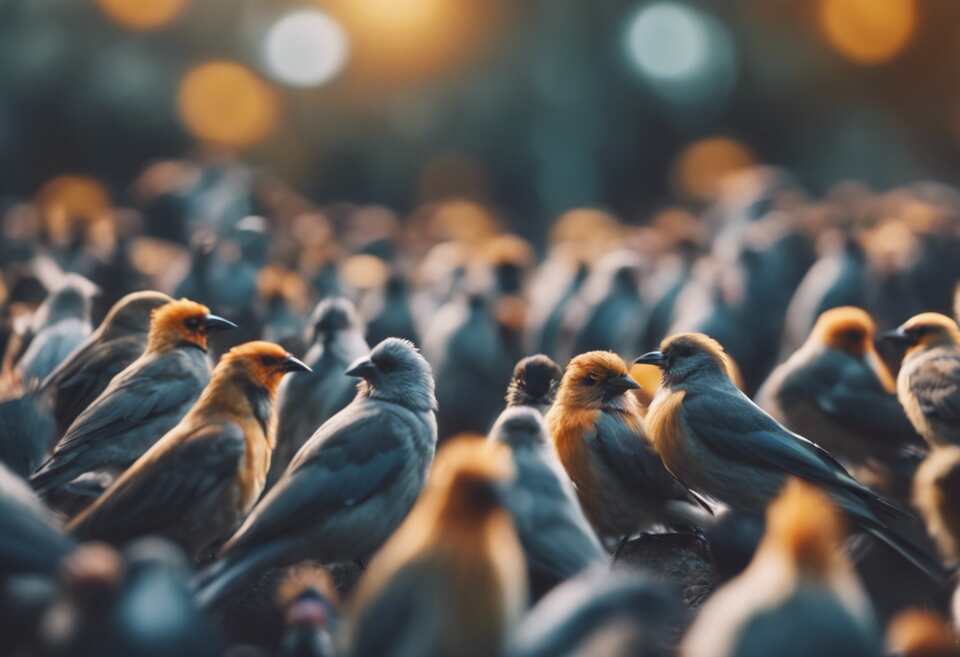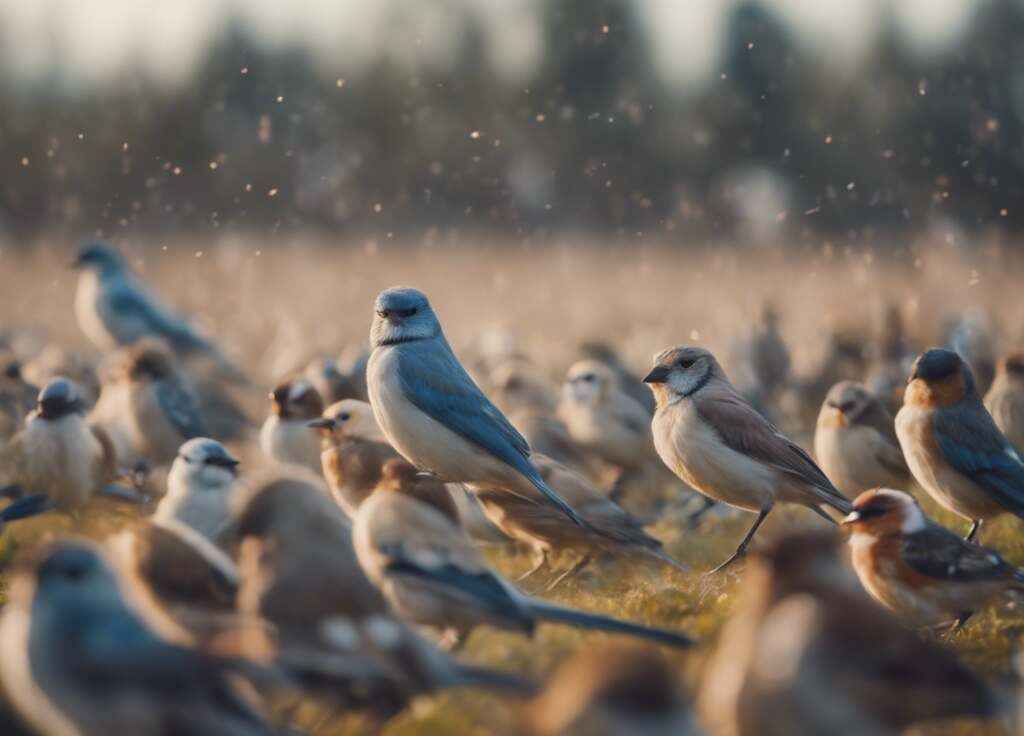Birds are fascinating creatures, and one of the most intriguing behaviors they exhibit is the tendency to gather in large groups, often referred to as flocks or murmurations. These collective gatherings serve a variety of purposes, and understanding the reasons behind this phenomenon can provide valuable insights into the complex social and survival strategies of our feathered friends.
Table of Contents
Reasons for Birds Congregating in Large Groups
Survival Strategies: Protection in Numbers
One of the primary reasons birds congregate in large groups is for the purpose of mutual protection. When birds flock together, they present a more formidable presence to potential predators, making it more challenging for individual birds to be singled out and targeted. This collective defense mechanism not only deters predators but also allows the birds to share the burden of vigilance, with more eyes and ears on the lookout for threats. By working together, the birds can increase their chances of survival and minimize the risk of being caught off-guard.
Foraging and Resource Sharing
Another key reason for birds to gather in large groups is the benefits of collective foraging and resource sharing. When birds congregate, they can more effectively locate and access food sources, such as dense patches of insects or seeds. By working together, they can cover a larger area and communicate the availability of food, ensuring that the group as a whole can take advantage of these resources. Additionally, the presence of a larger flock can make it more difficult for individual birds to be displaced from a valuable food source by more dominant individuals.
Social Interactions and Courtship Displays
Flocking behavior in birds also serves an important social function. Large groups provide opportunities for birds to engage in social interactions, such as courtship displays, mating rituals, and the establishment of social hierarchies. These interactions are crucial for the birds’ reproductive success and the maintenance of healthy populations. The presence of a larger group can also attract potential mates, as the collective display of the flock can be a powerful signal of the birds’ health and desirability.
In some species, the act of flocking can also provide navigational advantages, particularly during long-distance migrations. Birds flying in formation, known as a “V-shaped” pattern, can benefit from the aerodynamic effects of the group, reducing the amount of energy required to travel long distances. Additionally, experienced birds within the flock can act as “leaders,” guiding the group to their destination using their knowledge of migration routes and environmental cues.
Thermal Regulation and Communal Roosting
In colder climates, birds may congregate in large groups to take advantage of the thermal benefits of communal roosting. By huddling together, the birds can conserve body heat and reduce the individual energy expenditure required to maintain their body temperature. This strategy is particularly important for smaller bird species, which have a higher surface area to volume ratio and are more susceptible to heat loss.
The reasons for birds to gather in large groups are diverse and serve a range of important functions, from enhancing survival and foraging strategies to facilitating social interactions and navigational advantages. Understanding these behaviors not only satisfies our natural curiosity about the lives of birds but also provides valuable insights that can inform conservation efforts and our appreciation of the intricate relationships within the natural world.

The Benefits and Drawbacks of Flock Behavior in Birds
Birds are fascinating creatures, and their behavior in large groups, known as flocks, is particularly intriguing. Flock behavior is a common sight in the natural world, with birds of various species coming together for a variety of reasons. Understanding the benefits and drawbacks of this behavior can provide valuable insights into the complex lives of our feathered friends.
The Advantages of Flock Behavior
One of the primary benefits of flock behavior in birds is the enhanced ability to find and share resources. When birds travel and forage in groups, they can more effectively locate food sources, water, and other essential elements for survival. This collaborative approach increases the chances of individual birds finding what they need, especially in areas with scarce resources.
Another significant advantage of flock behavior is the increased protection from predators. By traveling in large groups, birds can more effectively detect and avoid potential threats. The presence of many eyes and ears in a flock enhances the collective vigilance, making it more difficult for predators to single out and target individual birds. Additionally, the sheer numbers of a flock can deter some predators from attempting an attack, as the risk of being overwhelmed increases.
The social aspects of flock behavior also contribute to its benefits. Birds within a flock can learn from one another, sharing information about the best foraging areas, roosting sites, and migration routes. This exchange of knowledge helps to improve the overall survival and reproductive success of the group. Furthermore, the social interactions within a flock can foster a sense of community and belonging, which may be particularly important for migratory species that need to navigate long distances.
The Drawbacks of Flock Behavior
While flock behavior offers many advantages, it also comes with some drawbacks. One of the primary challenges is the increased competition for resources within the group. As the number of birds in a flock increases, the demand for food, water, and nesting sites can become more intense. This can lead to conflicts and aggressive behavior among the flock members, as they strive to secure their share of the available resources.
Another potential drawback of flock behavior is the increased risk of disease transmission. When birds congregate in large groups, the likelihood of the spread of infectious diseases and parasites rises. Diseases can quickly spread through a flock, putting the health and well-being of individual birds at risk. This can have significant consequences for the overall population, especially if the affected birds are unable to recover or continue to participate in the flock’s activities.
The size and density of a flock can also present challenges in terms of navigation and coordination. As the number of birds increases, it becomes more difficult for the flock to maintain cohesion and move efficiently, especially during migration or in response to potential threats. This can increase the risk of collisions, disorientation, and the disruption of the flock’s movements.
Flock behavior in birds is a complex and multifaceted phenomenon, with both benefits and drawbacks. While the advantages of improved resource acquisition, predator avoidance, and social learning are significant, the drawbacks of resource competition, disease transmission, and coordination challenges must also be considered. Understanding these dynamics can help us appreciate the intricate lives of birds and the delicate balance they maintain within their natural environments.

Conclusion
Birds are social creatures that often gather in large groups, or flocks, for a variety of reasons. As we’ve explored, the primary motivations behind this behavior include protection from predators, improved foraging efficiency, and social interaction. While flocking does offer significant benefits, it also comes with some drawbacks that birds must navigate.
The safety in numbers provided by flocking is perhaps the most well-known advantage. When birds band together, they can more effectively spot and respond to threats, with multiple pairs of eyes and ears on the lookout. Additionally, predators often have a harder time singling out and targeting individual birds within a large group. This communal vigilance allows the birds to devote more time to other essential activities, such as feeding and resting.
Foraging is another area where flocking behavior provides advantages. When birds work together, they can cover more ground and share information about the location of food sources, increasing their collective chances of finding sustenance. This is particularly beneficial in environments where resources are scarce or unpredictably distributed. By cooperating, the birds can maximize their food intake and ensure their collective survival.
The social aspect of flocking should not be overlooked either. Birds, like many other animals, are inherently social creatures that derive benefits from interacting with their own kind. Flocking allows for the exchange of information, the development of social bonds, and the potential for mating opportunities. These social interactions can contribute to the overall well-being and fitness of the birds, as they navigate the challenges of their environment.
However, the aggregation of birds in large groups is not without its drawbacks. One of the primary concerns is the increased risk of the spread of disease. When birds are in close proximity, pathogens can more easily transmit from one individual to another, potentially leading to outbreaks that can decimate the entire flock. Additionally, the high concentration of birds in a given area can deplete local resources more quickly, forcing the flock to expend more energy in search of new foraging grounds.
Another potential downside of flocking is the increased competition for mates and other resources. As the size of the flock grows, the chances of any individual bird successfully securing a mate or accessing the best feeding spots may diminish. This can lead to conflicts and social hierarchies within the group, which can ultimately impact the overall fitness and survival of the birds.
Despite these drawbacks, the benefits of flocking behavior in birds generally outweigh the risks, as evidenced by the prevalence of this behavior across a wide range of avian species. By working together, birds are able to better navigate the challenges of their environments and increase their chances of survival and reproduction.
As we continue to study and observe the fascinating world of avian behavior, the reasons behind the flocking tendencies of birds will undoubtedly become even more clear. Whether it’s the safety in numbers, the efficiency of foraging, or the social connections that drive this behavior, one thing is certain: the collective nature of birds is a testament to the power of cooperation and the ingenuity of the natural world.



